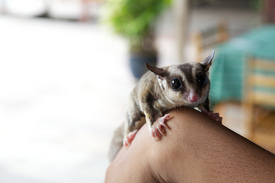As sugar gliders gain popularity, is emphasis on understanding their physical and ethological needs enough?

flickr photo courtesy of I'm George
Sugar gliders are a hot commodity: they’re small, unique and seemingly easy to care for, and that's attractive to a lot of people.
The cute factor is clear, but what makes them unusual is their ability to do what you don't expect a furry creature to be able to: move through the air.
Perhaps that's what makes sugar gliders such irresistible pets. Or maybe it's their sociability.
Unscrupulous people who sell these animals bank on those things to work to their advantage.
Reasons these natives of places like Australia and Indonesia are out-of-the-ordinary go far beyond diet and veterinary needs. And as you'll learn, one trait that many people underestimate in the beginning, in many cases finds these creatures in need of rehoming.
The lack of understanding of just how much care sugar gliders really need, both from a physiological and ethological standpoint, has many people wondering where the proverbial line needs to be drawn.
Gliding through the air is one ability that most anyone who has heard of sugar gliders (hence, the name) is familiar with. They are able to because of a membrane — patagium.
As with many exotic pets, they do have specialized dietary needs, and as Dr. Cathy Johnson-Delaney, DVM, an expert in exotic animal medicine based in Washington state notes, special attention needs to be paid in many areas.
Sugar gliders are omnivores, and. just as with most other exotic pets, commercial diets on the market are not optimal, contrary to what some people would like to believe. Close attention to variety and balance in the diet is paramount — as is proper calcium intake, just like with many other exotics.
Pelleted avian diets, which are readily available, should be included, as should a variety of fruits and vegetables (chopped and mixed so that the animals can't pick out only what they like). Eggs and insects — the latter should be gut-loaded with high-calcium diets before feeding to sugar gliders — need to be provided as well. Proper calcium intake is crucial for sugar gliders, as they can develop conditions like metabolic bone disease and hind leg paralysis, or HLP.
As their name indicates, sugar gliders have quite the sweet tooth and will easily load up on sweet treats if given the chance, and these little animals thrive when fed in the evening hours.
Chocolate is deadly to sugar gliders.
Exotic animal clinicians at Purdue School of Veterinary Medicine point out that Leadbeater’s Mix has been useful in raising captive sugar gliders, as has Mazuri commercial insectivore diet. Resources for these and other zoo-formulated diets, as well as tips on how to feed can be found by clicking here.
Additionally, sugar gliders do need periodic veterinary wellness visits with a professional experienced in their care.
They are highly active and social creatures and require a lot of interaction with their humans, and ideally with other sugar gliders, so getting more than one is preferable. Those thinking of bringing a sugar glider into the family are told to spend plenty (hours, not minutes) of time bonding with their animal and to provide them with the engagement they need on a daily basis.
Enclosures are a big consideration as well, and unfortunately most of the cages that are available on the market are far from ideal — sugar gliders need a lot of room and vertical space, as they are jumpers and climbers. They also need climbing branches, nesting boxes or slings that are properly placed and enrichment toys. Wooden toys used for exotic birds are ideal and safe.
Whew.
So, do you think that you have what it takes to commit to caring for one of these animals for up to 15 years — their expected life span? Consider carefully, as one trait that is part of their species may not bode well: they love to stay up all night. It's nothing personal; sugar gliders are nocturnal.
After considering all of this information, it seems the questions on so many minds are:
"Should these creatures be bred to be sold as pets?" and "Are we moving in the right direction when it comes to considering what's best for them?"
In some states, it isn't even legal to own a sugar glider as a pet.
If you're seriously considering having these as pets, it goes without saying that you need to know what to look for, and a lot of research is needed on where you get them from.
First, you might consider checking your local shelter or rescue for homeless sugar gliders.
And since there is an obvious market for them, there are breeders — like it or not — so it begs the question of how to recognize a bad situation.
All in all, transparency is important when it comes to finding a great breeder of any species.
Those people encourage an open dialogue when you pose questions about who they are and what they are about. (They should ask you questions as well!) A reputable breeder (as opposed to a retailer, which is of course never a good idea) should be open to you visiting their fixed location and be able to provide references of past clients you can talk with as well. They won't pressure a sale.
After all, sugar gliders are not an impulse item.
So where do you feel the line should be drawn? Leave your comments below.
Lorrie Shaw is lead pets blogger for AnnArbor.com. Catch her daily dog walking and pet sitting adventures or email her directly.

